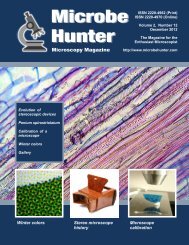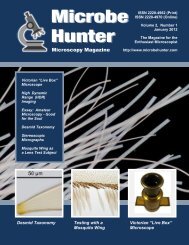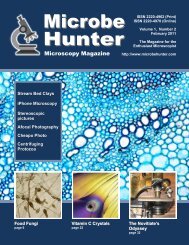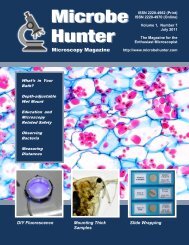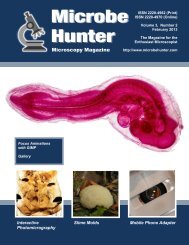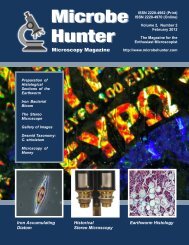October 2012 - MicrobeHunter.com
October 2012 - MicrobeHunter.com
October 2012 - MicrobeHunter.com
Create successful ePaper yourself
Turn your PDF publications into a flip-book with our unique Google optimized e-Paper software.
Plant Leaves<br />
OBSERVATIONS<br />
even dissolve the impression. It is also<br />
important that the refractive index of the<br />
mounting medium is different from the<br />
refractive index of the nail polish impression,<br />
otherwise the structures will<br />
not be visible. Evidently there are still<br />
many opportunities for experimentation.<br />
Other leaf tissues<br />
6<br />
UE<br />
A typical deciduous plant leaf is<br />
<strong>com</strong>posed of several layers. The top<br />
most layer of a leaf is a cell-free layer of<br />
wax, the cuticle. Its function is to reduce<br />
the loss of water from the cells. The<br />
waxy cuticle is produced by the upper<br />
epidermis. This layer of cells does not<br />
contain chloroplasts in order to allow<br />
sunlight to pass through unhindered.<br />
The palisade mesophyll is a layer of<br />
packed cells beneath the upper epidermis.<br />
The cells are arranged vertically<br />
and contain many chloroplasts. Their<br />
vertical arrangement and high density<br />
makes them an efficient layer for photosynthesis.<br />
Spaces between the individual<br />
palisade cells allow for the diffusion<br />
of CO 2 gas. Beneath the palisade mesophyll,<br />
one can find the spongy mesophyll.<br />
It is a loosely packed layer of<br />
cells, containing (as the name "spongy"<br />
suggests) many air spaces. This is the<br />
place where the gases CO 2 and O 2 are<br />
stored. Many cells are in contact with<br />
the air spaces and therefore the total<br />
surface area to loose water is also quite<br />
high. The lower epidermis is a single<br />
layer of cells on the bottom part of the<br />
leaf. It is the plant tissue which contains<br />
the guard cells and the stomata. With<br />
the exception of the guard cells, the<br />
lower epidermis is free of chloroplasts<br />
(figure 6).<br />
■<br />
Figure 5 (opposite page): This image<br />
shows a stack of the nail polish impression<br />
of the leaf surface.<br />
Figure 6: Cross section through a<br />
leaf. Abbreviations: UE: upper epidermis;<br />
P: palisade mesohyll, S: spongy<br />
mesophyll, LE: lower epidermis.<br />
Figures 7 and 8 (next page): The epidermis<br />
of a tulip leaf.<br />
LE<br />
S<br />
P<br />
<strong>MicrobeHunter</strong> Microscopy Magazine - <strong>October</strong> <strong>2012</strong> - 15



